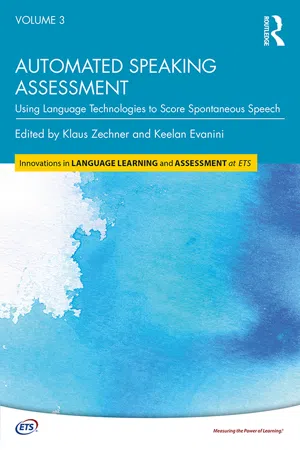
Automated Speaking Assessment
Using Language Technologies to Score Spontaneous Speech
- 212 pages
- English
- ePUB (mobile friendly)
- Available on iOS & Android
Automated Speaking Assessment
Using Language Technologies to Score Spontaneous Speech
About this book
Automated Speaking Assessment: Using Language Technologies to Score Spontaneous Speech provides a thorough overview of state-of-the-art automated speech scoring technology as it is currently used at Educational Testing Service (ETS). Its main focus is related to the automated scoring of spontaneous speech elicited by TOEFL iBT Speaking section items, but other applications of speech scoring, such as for more predictable spoken responses or responses provided in a dialogic setting, are also discussed. The book begins with an in-depth overview of the nascent field of automated speech scoring—its history, applications, and challenges—followed by a discussion of psychometric considerations for automated speech scoring. The second and third parts discuss the integral main components of an automated speech scoring system as well as the different types of automatically generated measures extracted by the system features related to evaluate the speaking construct of communicative competence as measured defined by the TOEFL iBT Speaking assessment. Finally, the last part of the book touches on more recent developments, such as providing more detailed feedback on test takers' spoken responses using speech features and scoring of dialogic speech. It concludes with a discussion, summary, and outlook on future developments in this area. Written with minimal technical details for the benefit of non-experts, this book is an ideal resource for graduate students in courses on Language Testing and Assessment as well as teachers and researchers in applied linguistics.
Frequently asked questions
- Essential is ideal for learners and professionals who enjoy exploring a wide range of subjects. Access the Essential Library with 800,000+ trusted titles and best-sellers across business, personal growth, and the humanities. Includes unlimited reading time and Standard Read Aloud voice.
- Complete: Perfect for advanced learners and researchers needing full, unrestricted access. Unlock 1.4M+ books across hundreds of subjects, including academic and specialized titles. The Complete Plan also includes advanced features like Premium Read Aloud and Research Assistant.
Please note we cannot support devices running on iOS 13 and Android 7 or earlier. Learn more about using the app.
Information
PART I
Introduction
1
Overview of Automated Speech Scoring
1. Motivation for This Book
2. Overview of the Field of Automated Speech Scoring
Table of contents
- Cover
- Half Title
- Series Page
- Title Page
- Copyright Page
- Table of Contents
- List of Figures
- List of Tables
- List of Contributors
- Series Editors’ Foreword
- Acknowledgements
- PART I: Introduction
- PART II: Components of an Automated Speech Scoring System
- PART III: Speech Features Introduction to Part III
- PART IV: Recent Developments and Outlook
- Appendix
- Index